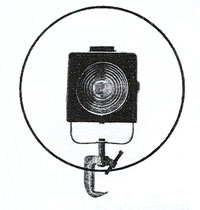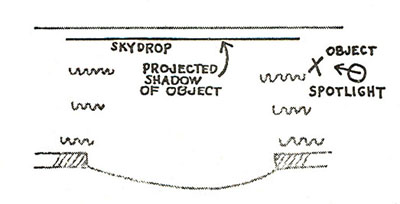

BY TOM SKELTON
courtesy of
Dance Magazine
first published
November 1956
TOOLS OF LIGHTING DESIGN: LIGHTING MISCELLANY
Projected Shadows
I have always had much more luck projecting shadows or light patterns, instead of attempting the more realistic projections listed above. For a barn dance, or a modern ballet with a barn dance theme, for example, it is quite simple to hang either an old lantern or a cardboard cut-out of an old lantern offstage in an upstage wing. A spotlight’s beam can hit it and carry the shadow onto the flat backdrop. Many objects can be projected in this way, including fans, head-dresses, the bars that “do not a prison make,” etc.

The object thus projected must be simple in line, its design being basically two-dimensional, but otherwise there are few problems. There will be some distortion, of course, since the object is projected from an angle, but distortion might be very interesting and modern in design. If a cut-out is used, however, the distortion can be compensated for in the cut-out.
Many ballets, particularly modern or abstract ballets, profit well from light patterns, streaks, or blobs on the backdrop. They often serve to add interest or focus to the choreography, in addition to their very obvious service to the cause of “variety of backdrop.” If a specific solo, for instance, begins and ends on the same spot on stage, it might be interesting to have a streak of light pointing to that spot projected on the backdrop. Color can be used interestingly in any of the light projections, or mobiles can be made of colored gelatine or plexiglass [sic] which project changing colored shapes.
I’m sure that it’s not necessary to warn you, however, that effects of this sort can be just as dangerous as they are helpful to the choreography unless they are used with extreme care and taste. During the rehearsal, you must watch the ballet carefully to be sure that at no time does the effect draw attention to itself and away from the performing dancer. If so, the effect must be eliminated for the entire ballet, or at least it must be dimmed so low for the conflicting sections that it no longer intrudes.
Plano-Convex Spotlight
In the May issue of DANCE Magazine we discussed the best type of equipment to buy; namely, Fresnels for general lighting and Lekos or Kleiglites for front lighting. But many auditoriums already have a good supply of plano-convex spotlights, often called “baby spots” or “Majors.”
In simplest terms, this kind of spotlight is a box with a lens on one often with a reflector behind the high-powered lamp mounted inside. There is a focus knob or thumb screw that moves the lamp forward when you want the beam of light to be large (“flood focus”) or back when you want it to be small (“spot focus”). This beam of light is sharp-edged, with little or no spill.
The small plano-convex spotlights (from 250 to 400 watts) are not very powerful since they are not designed as efficiently as the more modern spotlights; therefore, they must be used close to the stage, either as wing lights or mounted on the first pipe, and it is necessary to have quite a few of them to cover the dance area. In order to get as much intensity of illumination as possible out of this type of instrument, it must be almost on “Spot focus.”
Of course, if you have only a few “baby spots,” and no other spotlight, you must use them only for accent to give form to the dancer’s body, and your general illumination will have to come from the footlights and borderlights. If this is the case, I would suggest that you make a rich lavender wash with the foots and borders and use the baby spots” without gelatine or other color media; the reason is that by using the “baby spots” without a “gel” you will get much more light out of them. The “white” light will be slightly amber and will not be too unattractive if the general illumination is rich enough to counteract it. Although I would not recommend the use of white light without gelatine, the preceding is one example of where it may be necessary, but only if you are strapped for equipment.
A larger plano-convex spotlight (from 500 to 2000 watts) can be successfully used as a follow-spot from the wings if it is mounted on a standard that swivels easily. It can also be used from the first light pipe. When it is in “flood focus,” it produces an amazingly large puddle of light, so large in fact that one or two will cover the average stage. Of course, on “flood focus” they do not have much power; therefore, they are best used with a very light tint of amber, straw, or pink, or no gelatine (providing there is enough color from another light source to counteract the white light). However, if several large plano-convex spotlights are available, they can be focused half-way between “spot focus” and “flood focus.” Then the light they produce is quite satisfactory and powerful enough to permit the use of gelatine in the usual way.
(to be continued next month)